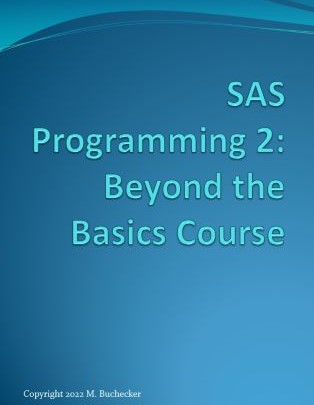
SAS Programming 2: Beyond the Basics Courseware (SASPRG2)
This course is for those who need to perform advanced data processing and manipulation, and create a variety of outputs. SAS Programming 2 builds on the concepts that are presented in the SAS Programming 1: Fundamentals course and is not appropriate for beginning SAS software users.
This course use data from the SASHELP library installed with the software. These courses can be taught
- using SAS Version 9 or higher
- any operating system (focus is either Windows or Linux/Unix. If using MVS you may need to modify as necessary)
- any interface (SAS Enterprise Guide is the focus. If using SAS Studio or SAS Display Manager you may need to modify slightly as necessary)
- your installation of SAS, or SAS On Demand for Academics (free version of SAS for learning purposes)
Publisher: MMB Training Solutions
Benefits
After completing this course students will be able to:
- Understand and control DATA step processing
- Create an accumulating column and process data in groups.
- Manipulate data with functions.
- Create custom formats.
- Process repetitive code using DO loops.
- Rotate data.
- Use the Debug feature on DATA steps in SAS Enterprise Guide.
- Make code flexible using simple macro facility techniques.
- Join data using PROC SQL
Outline
- Introduction
- Explain course logistics.
- Explain course overview.
- Review SAS syntax.
- Controlling Input and Output
- Use the Delete, Output, and subsetting IF statements to control writing data.
- Create multiple data sets in the same DATA step.
- Use DROP and KEEP to control variables output.
- Use FIRSTOBS and OBS to control observations input.
- Manipulating Data with Functions
- Review the purpose of functions.
- Manipulate character data by changing the case, combining and extracting strings, and other data manipulation techniques.
- Use summary functions in the DATA step.
- Use SAS Date functions to manipulate SAS data variables and create SAS dates.
- Convert a variable from one data type to another.
- Summarizing Data
- Create an accumulating total variable.
- Accumulate totals for a group of data.
- Processing Data Iteratively
- Perform repetitive processing with DO-loops.
- Describe SAS array processing.
- Use SAS arrays.
- Restructuring a Data Set
- Rotate data with the DATA step.
- Use the TRANSPOSE procedure.
- Combining SAS Data Sets
- Use the IN= option with match-merging in the DATA Step.
- Join data using PROC SQL.
- Creating User Defined Formats
- Create a format using PROC FORMAT.
- Use a created format.
- Writing Flexible Code with the SAS Macro Facility
- Use macro variables for text substitution.
- Write simple macro definitions.
- Supply parameters.
- Enhancing Your Output
- Describe the concepts of the Output Delivery System.
- Create Text Output.
- Create HTML Output.
- Create RTF Output.
- Create PDF Output.
- Debugging Your SAS Programs
- Use the DEBUG option.
- Use the PUTLOG statement.
Required Prerequisites
You must have at least six months of experience writing SAS programs or have completed the SAS Programming 1: Fundamentals course and used SAS for at least one month. You need to be able to:
- submit a SAS program
- diagnose and correct syntax errors
- examine descriptor and data portions of a SAS data set
- access SAS data libraries
- read and create SAS data sets
- create variables
- combine SAS data sets
- use global statements
- use labels and formats
- filter observations
Useful Prerequisites
Before attending this course, it is useful to know the following:
- create a simple report with PROC SQL
License
Length: 3
days | $100.00 per copy
What is Included?
- Student Manual
- PowerPoint Presentation